Answered step by step
Verified Expert Solution
Question
1 Approved Answer
CASE SYNOPSIS A Senior Vice President for a midsized commercial bank is contemplating getting her bank to move forward in extending subprime loans. She
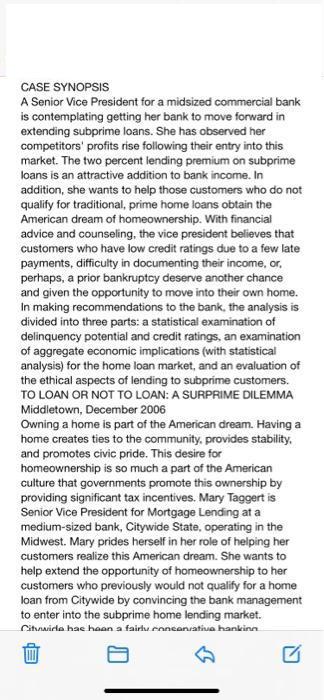
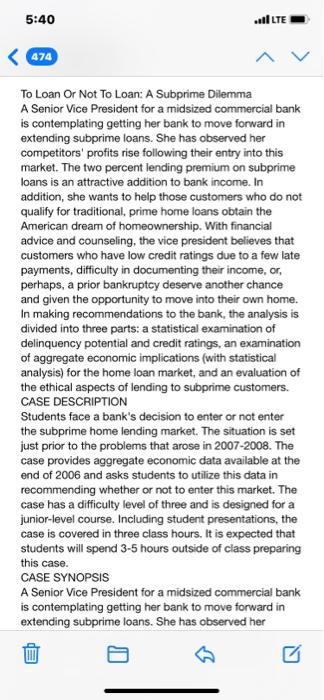

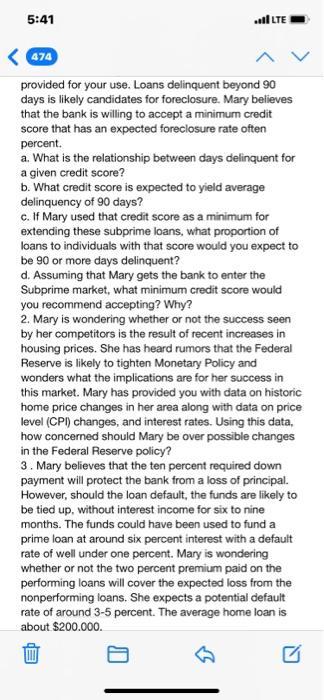
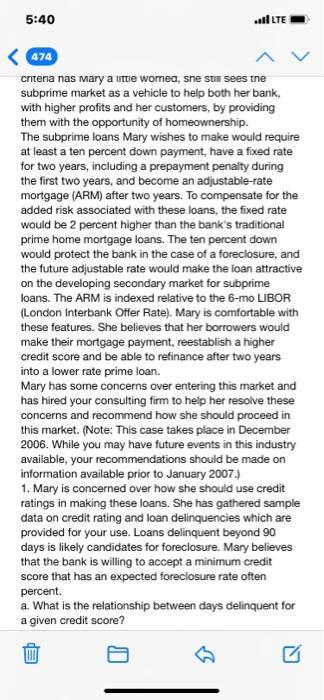
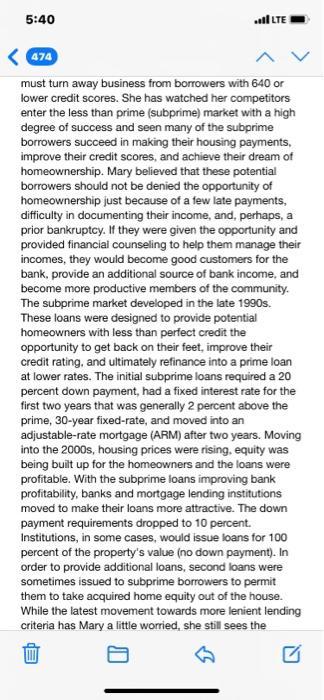
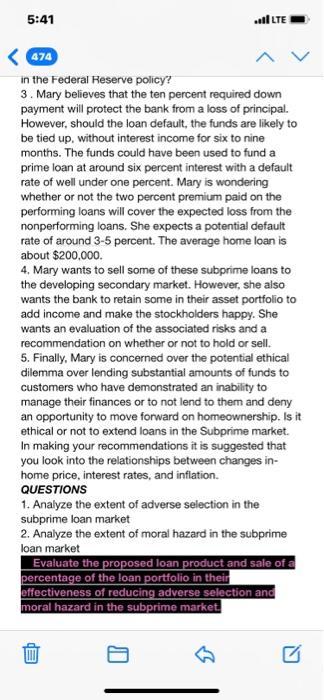
CASE SYNOPSIS A Senior Vice President for a midsized commercial bank is contemplating getting her bank to move forward in extending subprime loans. She has observed her competitors' profits rise following their entry into this market. The two percent lending premium on subprime loans is an attractive addition to bank income. In addition, she wants to help those customers who do not qualify for traditional, prime home loans obtain the American dream of homeownership. With financial advice and counseling, the vice president believes that customers who have low credit ratings due to a few late payments, difficulty in documenting their income, or, perhaps, a prior bankruptcy deserve another chance and given the opportunity to move into their own home. In making recommendations to the bank, the analysis is divided into three parts: a statistical examination of delinquency potential and credit ratings, an examination of aggregate economic implications (with statistical analysis) for the home loan market, and an evaluation of the ethical aspects of lending to subprime customers. TO LOAN OR NOT TO LOAN: A SURPRIME DILEMMA Middletown, December 2006 Owning a home is part of the American dream. Having a home creates ties to the community, provides stability. and promotes civic pride. This desire for homeownership is so much a part of the American culture that governments promote this ownership by providing significant tax incentives. Mary Taggert is Senior Vice President for Mortgage Lending at a medium-sized bank, Citywide State, operating in the Midwest. Mary prides herself in her role of helping her customers realize this American dream. She wants to help extend the opportunity of homeownership to her customers who previously would not qualify for a home loan from Citywide by convincing the bank management to enter into the subprime home lending market. Cituirle has hean a fairly enneonativa hankinn 5:40 474 LTE To Loan Or Not To Loan: A Subprime Dilemma A Senior Vice President for a midsized commercial bank is contemplating getting her bank to move forward in extending subprime loans. She has observed her competitors' profits rise following their entry into this market. The two percent lending premium on subprime loans is an attractive addition to bank income. In addition, she wants to help those customers who do not qualify for traditional, prime home loans obtain the American dream of homeownership. With financial advice and counseling, the vice president believes that customers who have low credit ratings due to a few late payments, difficulty in documenting their income, or, perhaps, a prior bankruptcy deserve another chance and given the opportunity to move into their own home. In making recommendations to the bank, the analysis is divided into three parts: a statistical examination of delinquency potential and credit ratings, an examination of aggregate economic implications (with statistical analysis) for the home loan market, and an evaluation of the ethical aspects of lending to subprime customers. CASE DESCRIPTION Students face a bank's decision to enter or not enter the subprime home lending market. The situation is set just prior to the problems that arose in 2007-2008. The case provides aggregate economic data available at the end of 2006 and asks students to utilize this data in recommending whether or not to enter this market. The case has a difficulty level of three and is designed for a junior-level course. Including student presentations, the case is covered in three class hours. It is expected that students will spend 3-5 hours outside of class preparing this case. CASE SYNOPSIS A Senior Vice President for a midsized commercial bank is contemplating getting her bank to move forward in extending subprime loans. She has observed her 5:40 LTE 474 Citywide has been a fairly conservative banking institution, concentrating on commercial lending to local business and low-risk home loans. The home loans extended by Citywide are to prime borrowers. These borrowers have reasonably well-established credit and borrow in loans conforming to Fannie Mae or Freddie Mac criteria. Such loans can be packaged and sold through these government-sponsored agencies. The risk to the bank is low, many of the loans are sold to other institutions and pension funds while the bank earns fees for processing the payments. Prime borrowers generally had credit scores of 640 or higher. In managing the loan business for her bank, Mary sees her job as dealing with two significant problems. Prior to extending a loan, she must deal with adverse selection. Once the loan is extended she needs to provide sufficient incentives to reduce the moral hazard problem. Adverse selection results from asymmetric information. The potential borrower knows more about their likely behavior and financial condition than the bank. If the bank establishes a lending criterion that is significantly more lenient than its competitors, the borrowers selected are more likely to be higher risk and less likely to maintain their payments. Once the loan is extended the borrowers might expose the bank to unanticipated risk by failing to maintain the property. Mary sees this moral hazard problem is reduced by requiring a minimum down payment of 0 percent of the property's value. Since the first party to incur a loss, should the property value decline, is the homeowner. they have an incentive to maintain the value. The adverse selection problem is managed by screening the applicants. A potential borrower's credit score has proven to be a useful screening device. Mary has been frustrated by having a screening rule that only permits loans to highly qualified borrowers. Since her bank only issues prime mortgage loans, she must turn awav business from borrowers with 640 or 5:41 LTE
Step by Step Solution
★★★★★
3.54 Rating (161 Votes )
There are 3 Steps involved in it
Step: 1
To analyze the given information and address the questions lets break down the analysis into three parts Adverse Selection in the Subprime Loan Market ...
Get Instant Access to Expert-Tailored Solutions
See step-by-step solutions with expert insights and AI powered tools for academic success
Step: 2

Step: 3

Ace Your Homework with AI
Get the answers you need in no time with our AI-driven, step-by-step assistance
Get Started


